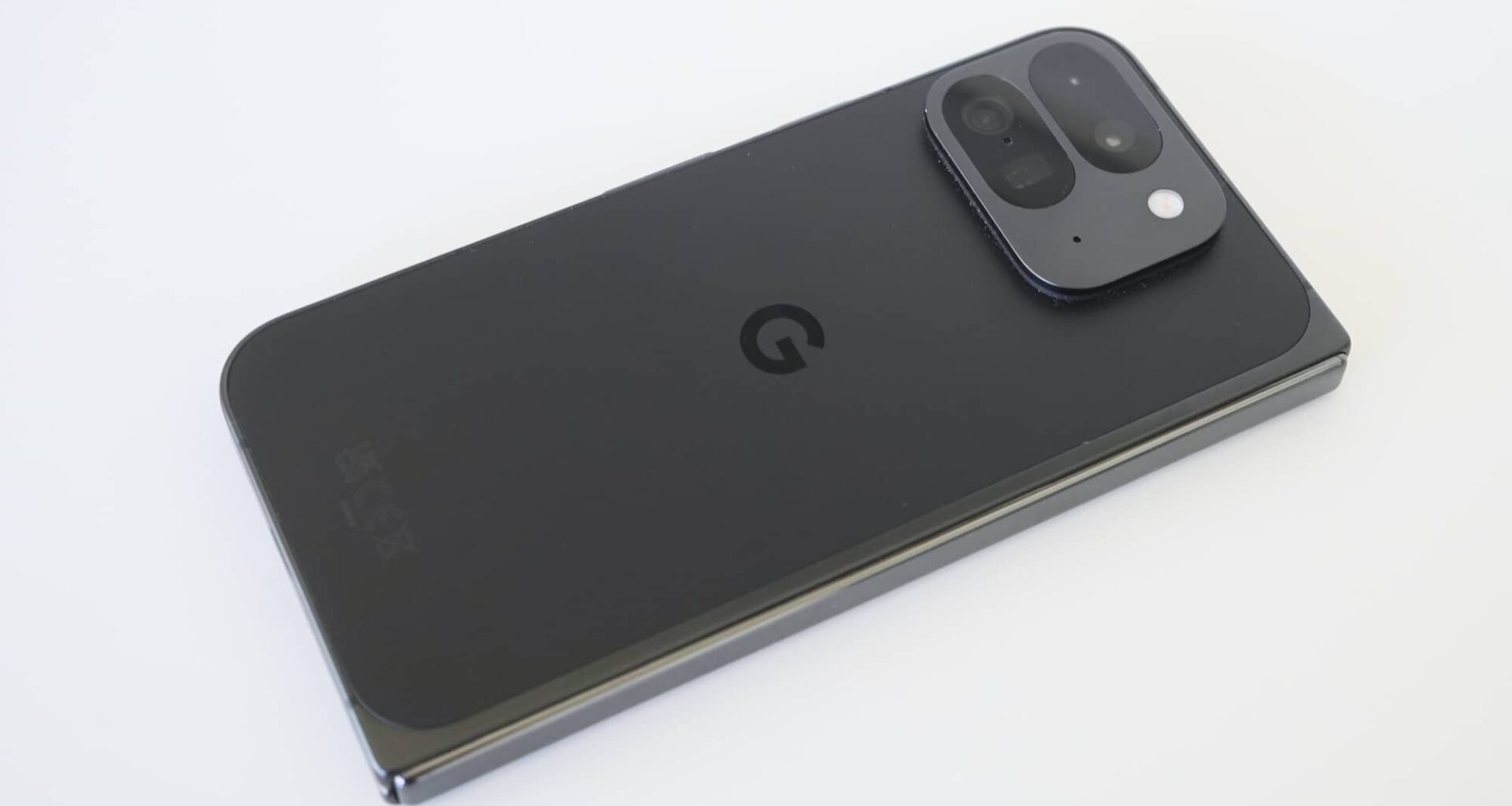Quick review
The good
The not-so-good
Measuring 10.5mm thin, the Google Pixel 9 Pro Fold manages to be slimmer than even Samsung’s sixth-gen Galaxy Fold, and packs in better cameras, too. Is it the foldable tablet to consider?
Near the end of 2024, it can be all too easy to forget that foldable phones are still so new that virtually no one has them. You might see someone using one on a bus, a train, or even glancing over with a bit of envy on a plane. What do they do with them, and is the technology good enough to replace a tablet at the same time?
Six years into foldables, the answer for some people is clearly “yes”, because we’re starting to see more take up of this form-factor. Tablet foldables are on the increase, and not just from buyers, but also the makers of them. Handset makers are building more of them joining Samsung with foldable devices, as the category now extends to foldable PCs, too.
Apple will probably be along with its own take on a foldable phone in the next couple of years, but Google is there now, ready with its second stab at a foldable. The first never arrived in Australia, but the second is coming to our little spot of paradise, borrowing the industrial design of the other Pixel 9 models it launches with, and pairing it with a big foldable screen and a solid feature set.
The priciest of this year’s Pixels, the Fold could win people over keen to have a Google-made phone and tablet that can keep in their pocket. Is this a combination worth having, or does it still need more work?
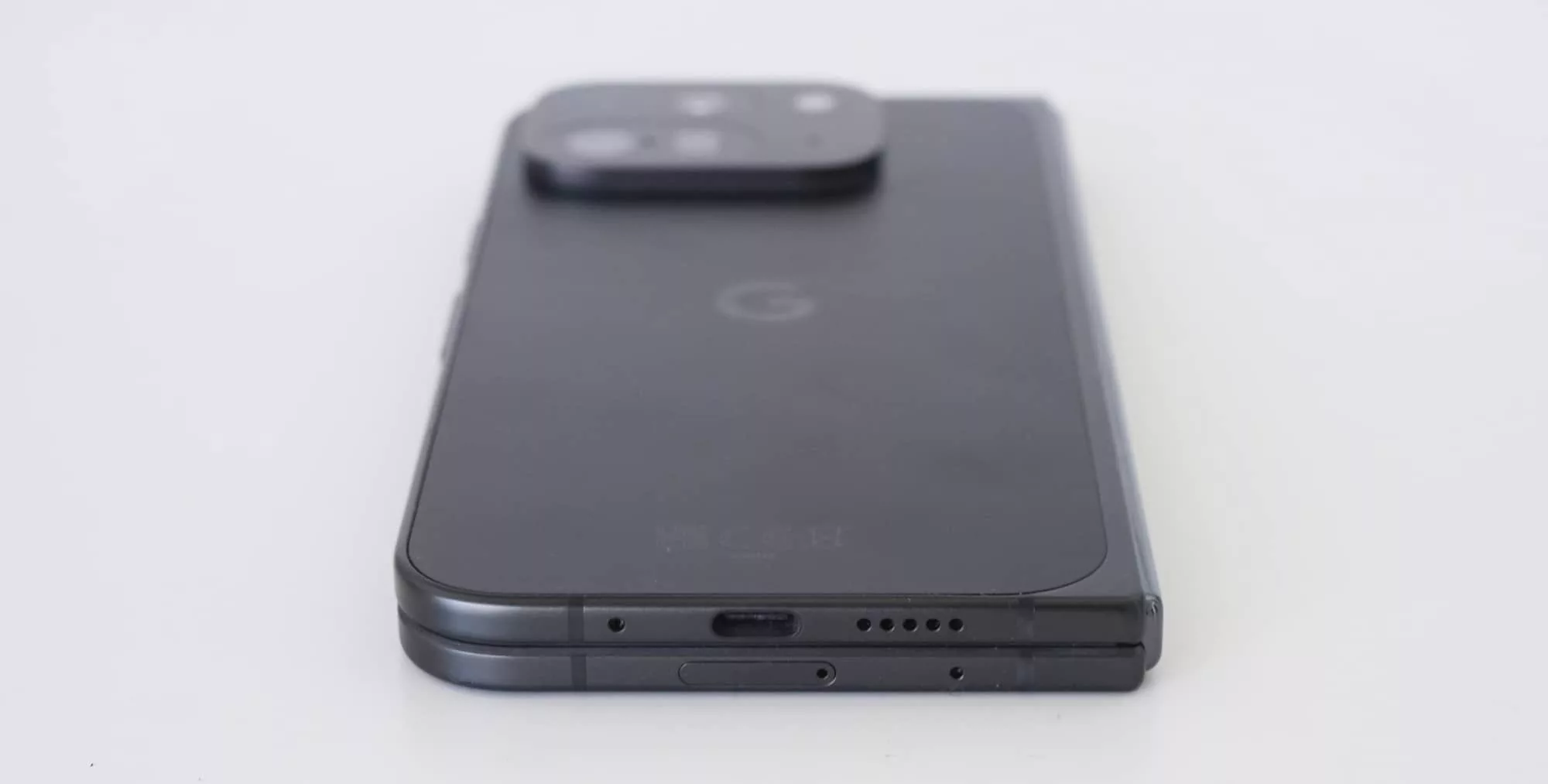
Design
What happens when you take the look of this year’s Pixel and you give an extra large screen inside ready to be unfolded and used? You get the Pixel 9 Pro Fold, a concept hat basically provides a tablet inside of a phone, as Google takes its foldable concept to round two, applying design tweaks and features from this year’s Pixel 9 range. Ish.
It’a similar look, albeit with a more obvious frame: while the Pixel 9 range sees a flat edge with curved corners, the Pixel 9 Pro Fold makes those corners more angular and encases the curves in the screen.
You can see it glancing down at the display from the front, and it’s all a little like a block holding a curved screen inside. As if someone took the 6.3 inch Pixel 9 and placed it ever so slightly in a more rectangular body.
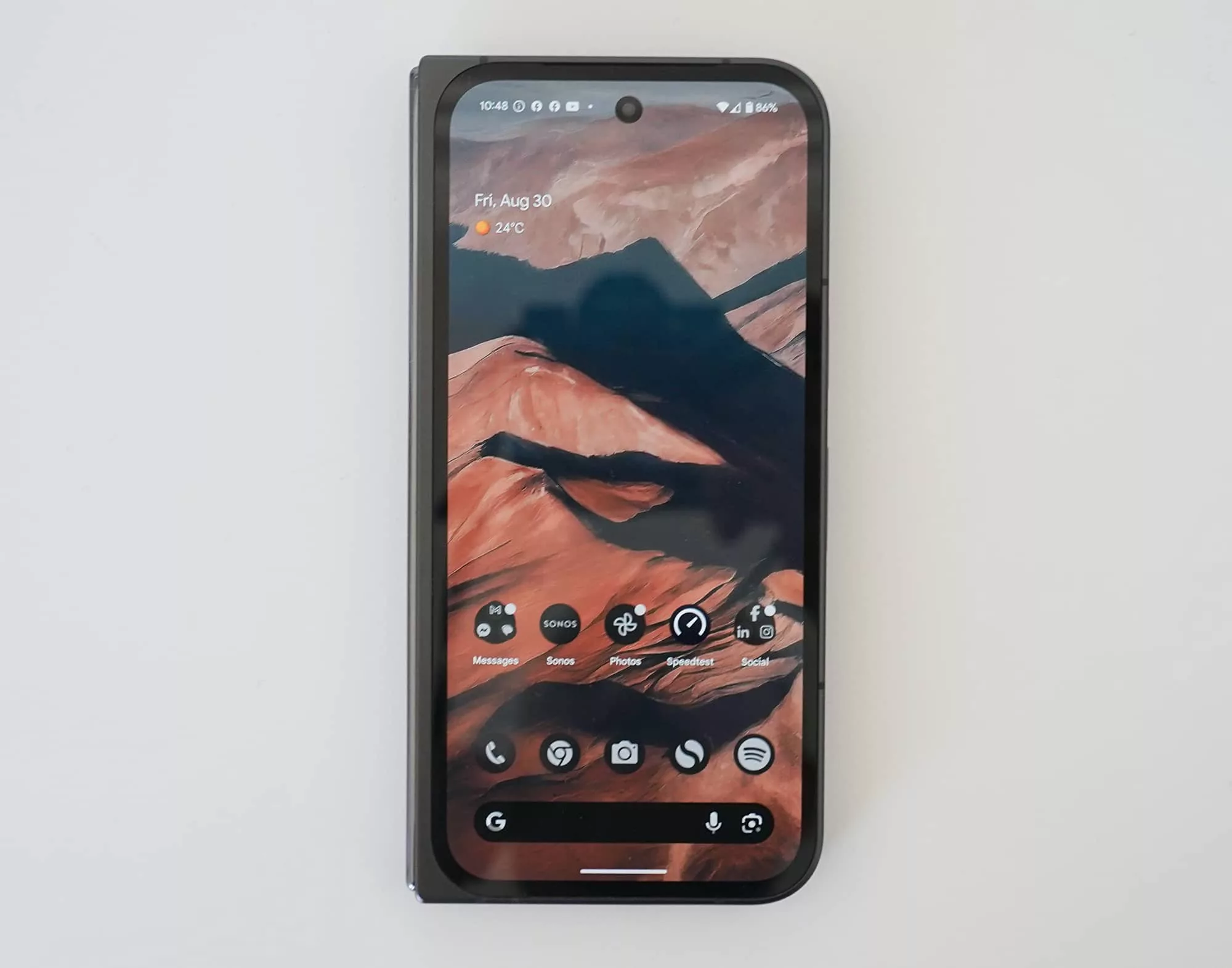
The flat edges are still there, but the whole thing is divided in two parts, measuring 5.1mm flat when opened and closed at 10.5mm. It’s a similar look to other foldables and also a similar style to the Pixel 9 models this year. This intriguing little halfway point just somehow manages to be slimmer than other foldable tablet phone models, and that’s not a bad thing.
Encased in steel and aluminium, and covered by Corning’s Gorilla Glass Victus 2 on the front and back, the Pixel 9 Pro Fold is a premium looking phone in just about every way.
Features
Inside, you’ll find Google’s Tensor G4 chip paired with 16GB RAM and a choice of either 256GB or 512GB storage, with no option for a 1TB foldable here.
The phone sees a decent amount of wireless options, covering 5G over sub-6 and mmWave, WiFi supported through 802.11a/b/g/n/ac/ax/be meaning it covers WiFi 7, Bluetooth 5.3, Ultra-Wideband, Near-Field Communication (NFC) for Google Pay, GPS, Google Cast, and supports both nanoSIM and eSIM. A physical USB-C port sits at the bottom of the phone, and is the one physical port found on the handset.

There are two buttons covering power and volume, as well as sensors for car crash detection (which interestingly only works when there’s network or mobile access), with most of the rest of the tech in the camera and the screen.
For the latter, you can find two screens to work with: the 6.3 inch Actua 1080×2424 OLED display supporting 120Hz, while the inside uses an 8 inch Super Actua Flex running 2076×2152 on a flexible OLED with support for 120Hz, as well. Two screens for the foldable phone, with even more cameras for the whole thing.
The rear of the phone sees three cameras, covering a 48 megapixel wide F1.7 camera, a 10.5 megapixel ultra wide F2.2 camera, and a 10.8 megapixel 5X telephoto set to F3.1, while two front-facing cameras are found for each of the screens. Just above the cover screen sees a 10 megapixel F2.2 selfie camera, while the 8 inch inside screen sports an identical extra 10 megapixel F2.2 camera in the top right of the display.
Underneath all of this is a 4650mAh battery able to be charged via both a wired Type C and a wireless Qi charger, though the wired will be faster on this phone, supporting as high as a 45W charger.
| Model | Google Pixel 9 Pro Fold |
| Chip | Google Tensor G4 |
| RAM/Storage | 16GB RAM; 256GB/512GB |
| Display | 6.3 inch OLED cover screen, 8 inch flexible OLED internal screen |
| OS | Android 14 |
| Cameras | 48mp wide F1.7, 10.5mp ultra-wide F2.2, 10.8mp 5X telephoto F3.1 |
| Connections | 5G, WiFi 7, Bluetooth 5.3, GPS, NFC, USB-C |
| Size/Weight | 10.5mm closed/5.1mm open, 257g |
| Price | Starting from $2699 AUD |
In-use
A foldable it may be, but you can use the Pixel 9 Pro Fold like any other phone.
There’s a fingerprint sensor on the side, an element of facial security if that’s faster, and while it launches with Android 14 (because 15 isn’t ready yet), using Android about as standard as it gets. Widgetised home screens, a choice of gestures or on-screen buttons, and all the apps you can find on the Google Play Store.
It’s all about normal, plus a degree of water resistance, supporting IPX8.
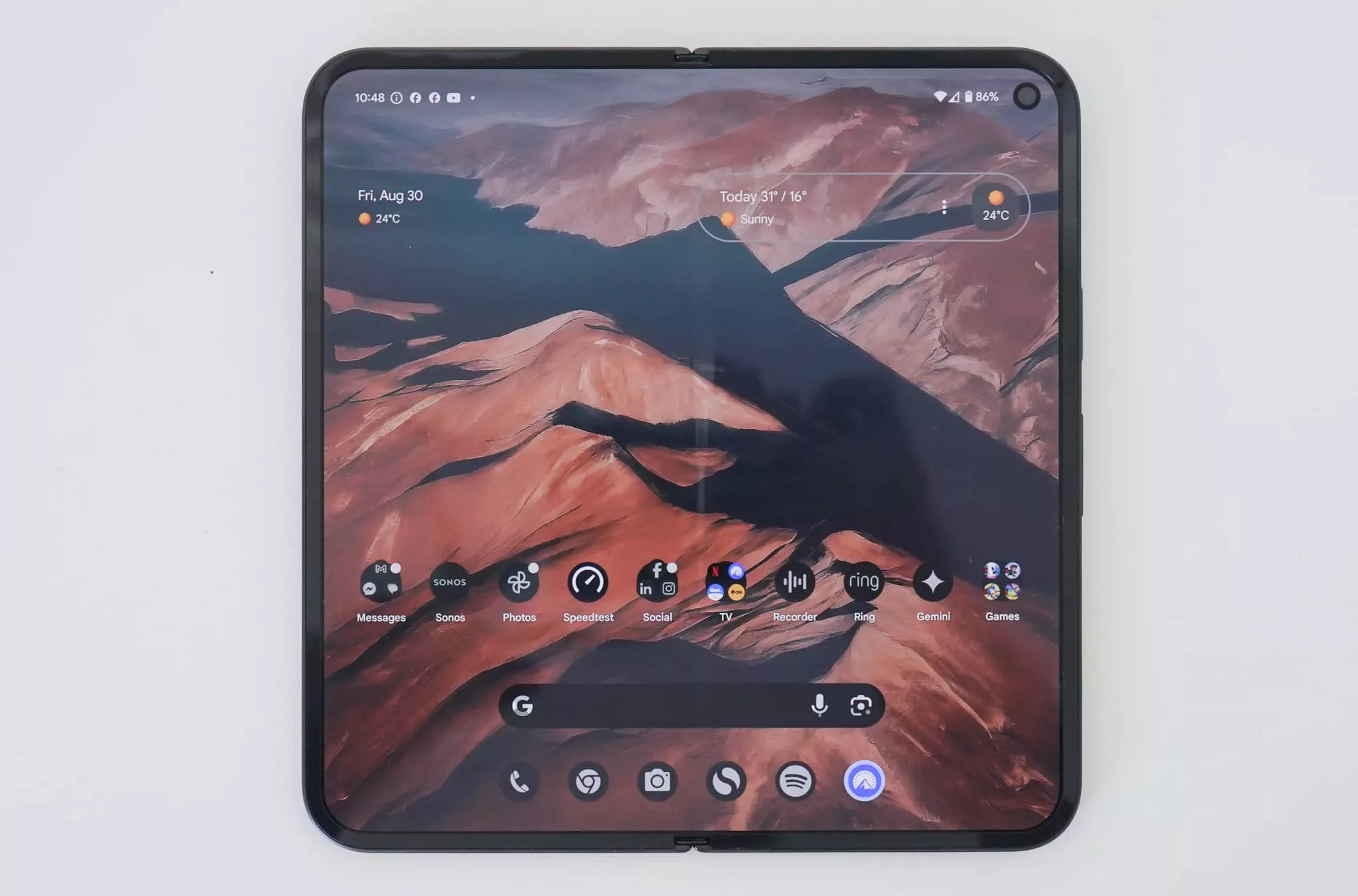
AI features
Like all phones this year, AI plays a part because everybody’s favourite trend and buzzword that won’t quit is in pretty much everything this year.
You’ll be able to make wallpaper using some generative AI, and you’ll even be able to have the Google Pixel Studio make other images out of nothing.
No humans yet, but it can make a lot of neat images with different styles, covering art, 3D, drawings, and even “cinematic” images that border on being more photographic. Handy for folks who don’t want to pay for Midjourney’s generative image making or any other AI image platforms.
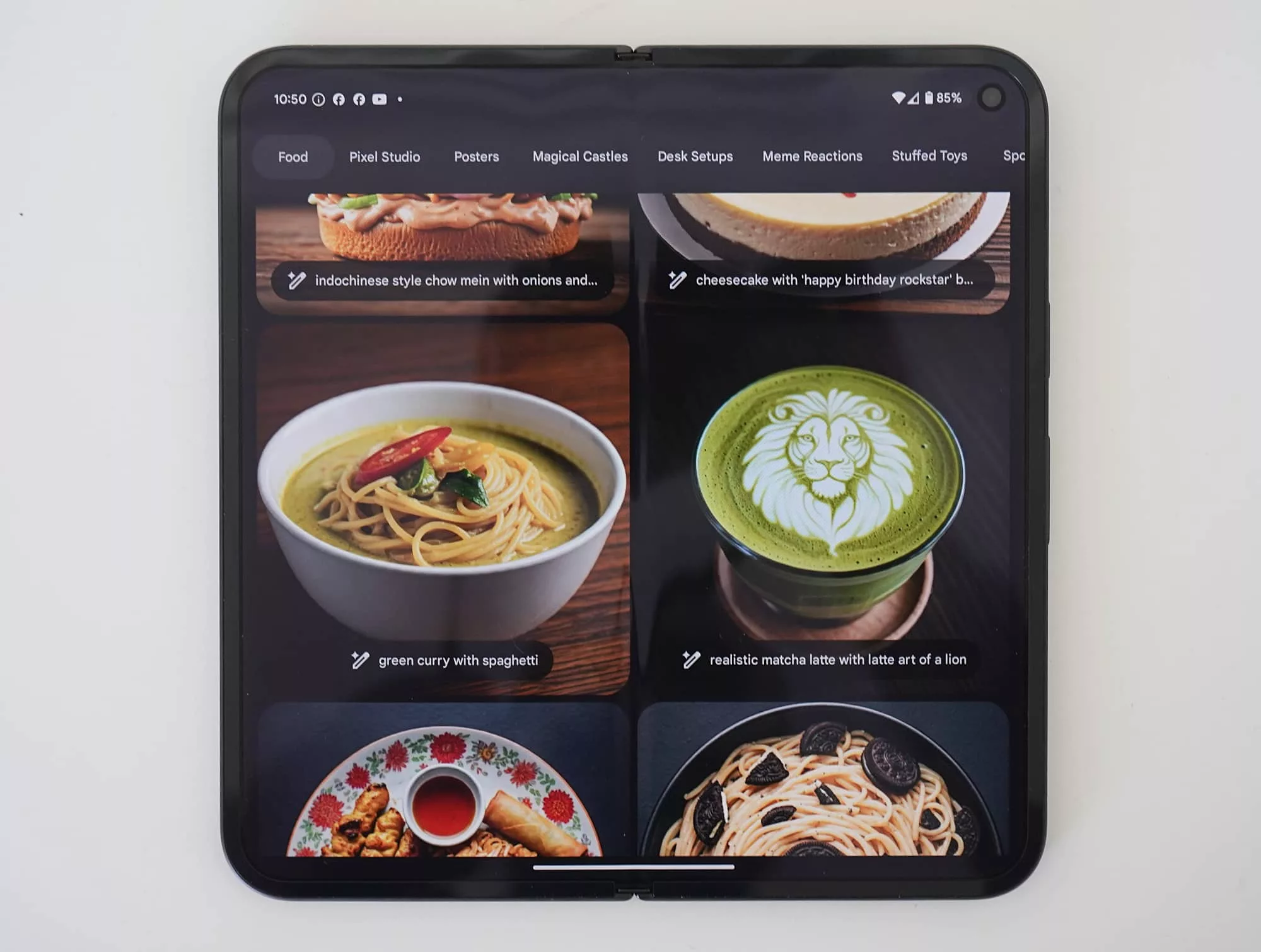
Google also has its Gemini system weaved into the phone, so you can talk to Google’s AI to find more information or have it understand aspects of your life.
We’re not sure the gimmick of AI is quite there for us yet, but it’s worth noting that much like we found with the Pixel 9 Pro XL, these features could all cost money very, very soon. Google’s Gemini Live feature technically will, and other AI features will be effectively pay to play sometime in the future.
One, however, may not: Google’s Screenshots app, which essentially analyses your screenshots to take information out and understand the context of what you snapped a screenshot of.
Grab a screenshot of a recipe and it’ll turn that into text. Snap a screenshot of a song you heard on your Sonos, and it’ll turn the song information into text, able to use it later. Take a screenshot of a recipe online and yep, you guessed it, the information will be there waiting for you.
We’re still not sure how AI will be helpful in a phone, but Screenshots gets us some of the way there.

As a phone
It’s worth remembering that the Pixel 9 Pro Fold is a phone. It’s a phone when closed revealing the cover screen, and it’s a phone when opened with the large 8 inch tablet screen.
But we suspect that most of the time, it will be a phone left closed with the 6.3 inch screen, and it performs rather like any other Android phone.
A big display awaits your touch and gestures, and just about as the standard Pixel 9, complete with an identical 1080×2424 OLED screen. Use it with the front screen, you’re basically using a Pixel 9 with a different camera setup and something extra inside once you open the phone up.
As a tablet
Unfold the Pixel 9 Pro Fold and you’ll find an 8 inch screen, and a flexible one at that.
Literally what makes the Fold a “foldable” phone, the 8 inch “Super Actua Flex Display” as Google calls it uses a 2072×2152 almost-square OLED panel running at 120Hz (but supporting 1 to 120Hz). That makes it a big screen for tablet-y purposes, which is really the point.
So what you use that big screen for is clearly part of the whole draw of the device, extending what you can do with a phone.
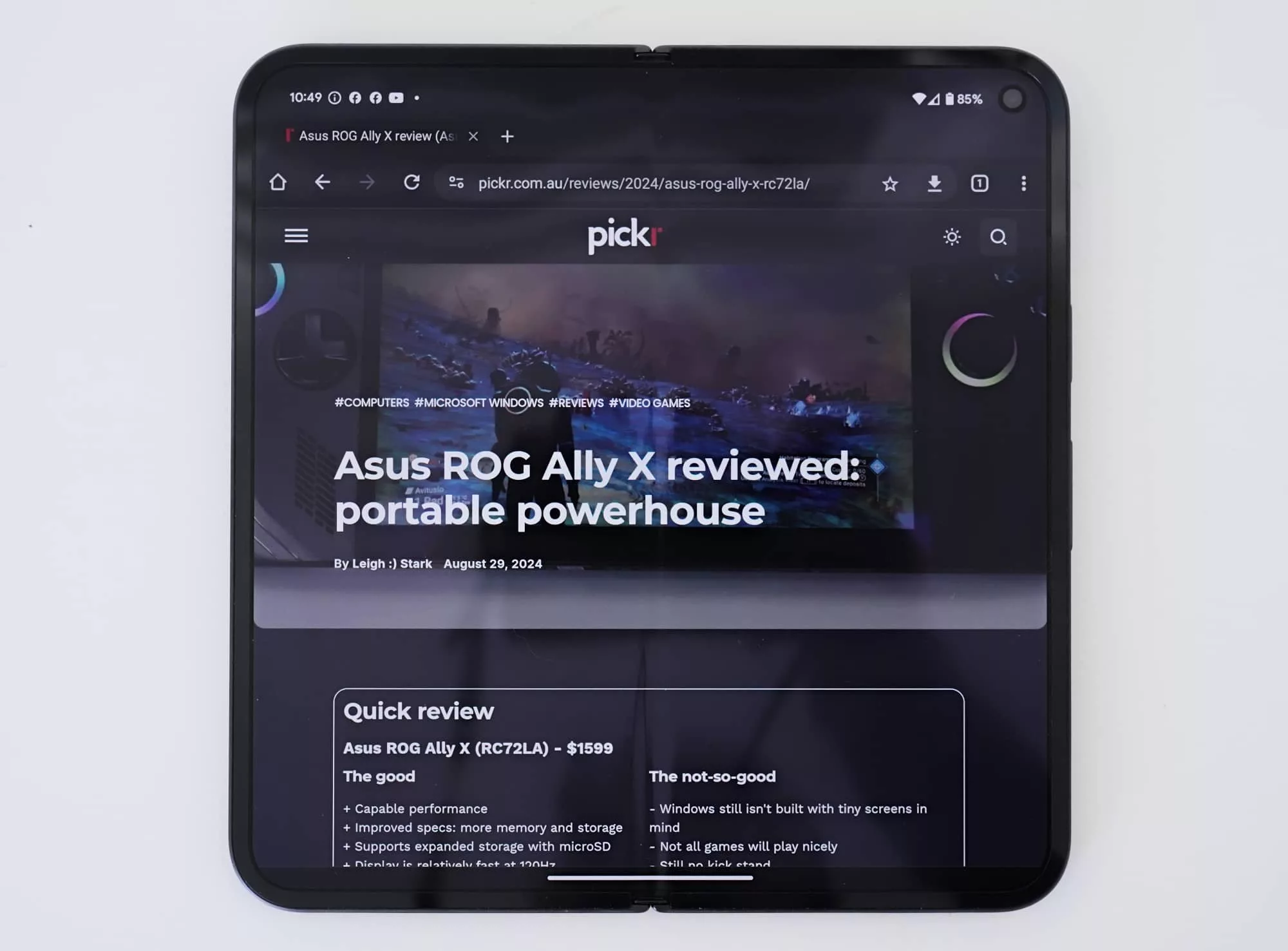
That should come as no surprise: it’s the exact same point Samsung has made with the Galaxy Fold models, but those have come with support for the S-Pen stylus. The Pixel 9 Pro Fold lacks stylus support, so what can you use it for?
Well, you can play games on a bigger display, as you open up the 6.3 inch widescreen of the external screen to reveal a bigger display almost like an old monitor. That’s a larger screen real estate for games, and for other things, too.
Web browsing sees more of the web page than a typical mobile would, and if you plan on doing some writing, you can bring up a big separated keyboard to type on a larger display. Alternatively, grab a wireless keyboard and type on the larger screen.
The crease on that screen appears a little more noticeable than on some of the other recent foldables we’ve seen, but over time your eyes will just look past it.
Interestingly, movies and TV shows don’t seem to benefit remarkably, largely because these days everything is letter-boxed in widescreen. It means when you watch a movie on that big 8 inch display, the widescreen presentation won’t be much bigger than the widescreen viewing you’d get with the 6.3 inch display on the outside. You don’t really need to unfold for bigger entertainment, it seems.

Performance
But with games being reliant on a meaty processor, you’re going to want to make sure Google’s Tensor G4 has the chops to handle those titles. So does it?
Maybe, maybe not.
Testing the Pixel 9 Fold with a few titles, it can definitely handle some of what’s out there reasonably well, and may hold up over time. We certainly had little to no lag in pretty much everything we did, and suspect the 16GB RAM helped somewhat, as well.
However, the benchmark tests tell a different story, and one that sees the Tensor G4 well behind this year’s other big and impressive chip, the Qualcomm Snapdragon 8 Gen 3.
Pit the Tensor against the Snapdragon used in Galaxy S Ultra models, and Qualcomm wins every time with a serious margin. The S24 Ultra delivers so much more in the scores using that Snapdragon model, and it’s a similar experience with older Snapdragon variations in other Galaxy models, too.
There’s just way more grunt in the Snapdragon than Google’s own processor, and while that’s not necessarily a be-all, end-all test, it’s still a sign that Google’s phone mightn’t have the chops to take on big games long term. Apps will likely be fine, but games leave us with a question mark.
Given how the big screen can be used for entertainment, that leaves the Pixel 9 Pro Fold in a curious situation, because it is technically slower than the pretty much every Galaxy flagship in the past couple of years.
The Pixel 9 Pro Fold is definitely faster than every recent Pixel model, barring the Pixel 9 Pro XL, which makes sense: it’s the same chip, so it would be pretty much the same across the board.
But compare the Pixel 9 Pro Fold to the Galaxy Fold 5 and Galaxy Fold 6, and the speed of each of those trounces what Google is offering.
We have to hope the performance will hold up, because Google has a plan for seven years of operating system updates in the Pixel 9 Pro Fold, much like it does the rest of the range.
It doesn’t quite have the edge on performance for phones this year, but it might not matter. Everything we tested on the Pixel Fold showed the handset had plenty of performance, even if the phone was beaten in the benchmarks as it was.
You should find solid 5G performance, too, with speeds as high as 306Mbps in our tests on the Telstra network in Sydney, Australia. Higher speeds are possible and will depend on factors such as your network and location, but it’s also worth knowing one other interesting fact about the Pixel 9 Pro Fold versus the other Pixel 9 models: this is the only model with a mmWave modem in Australia.

Google has removed mmWave from the other “Pro” models, and left it solely in the Pro Fold. That’ll be handy for travellers making their way to countries with more mmWave 5G — such as America — and even for locals keen to take advantage of the handful of locations where mmWave works in Australia.
Camera
Next up is the camera, and while we’ve already reviewed the excellent camera system of the Pixel 9 Pro XL — and this is technically named as a Pixel 9 Pro — the Pixel 9 Pro Fold has a totally different camera system.
That’s clearly not confusing at all.
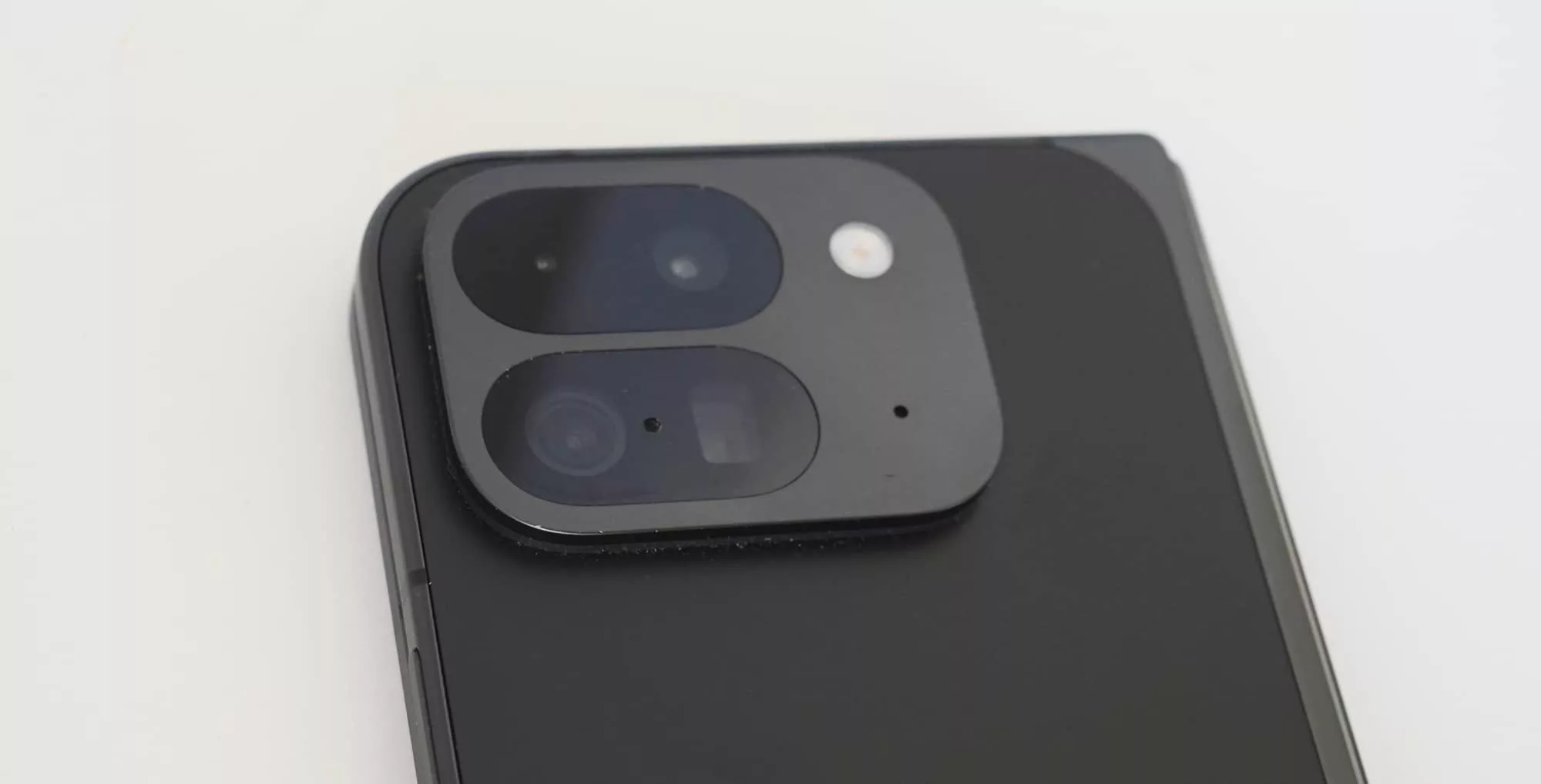
Instead of the combination of a 50 megapixel wide and two 48 megapixels for ultra-wide and 5X, the Pixel 9 Fold gets a 48 megapixel wide camera and two 10 megapixels for the ultra-wide and 5x telephoto. In short, you’re technically getting the same style of setup — three cameras covering ultra-wide, wide, and close — but set to different sensors, apertures, and megapixel amounts.
It’s a shame they’re not aligned, but the results were still quite good. The standard wide camera delivered crisp images in day and night, with great colour and detail, while the ultra-wide was fine, even if its macro felt a touch oversharpened at times.
The telephoto can help you get close, too, but the F3.1 aperture isn’t quite as nice as the F2.8 on the other Pro Pixel 9 models, and the four times reduction in megapixels means you don’t quite get as many pixels to work with on the foldable.




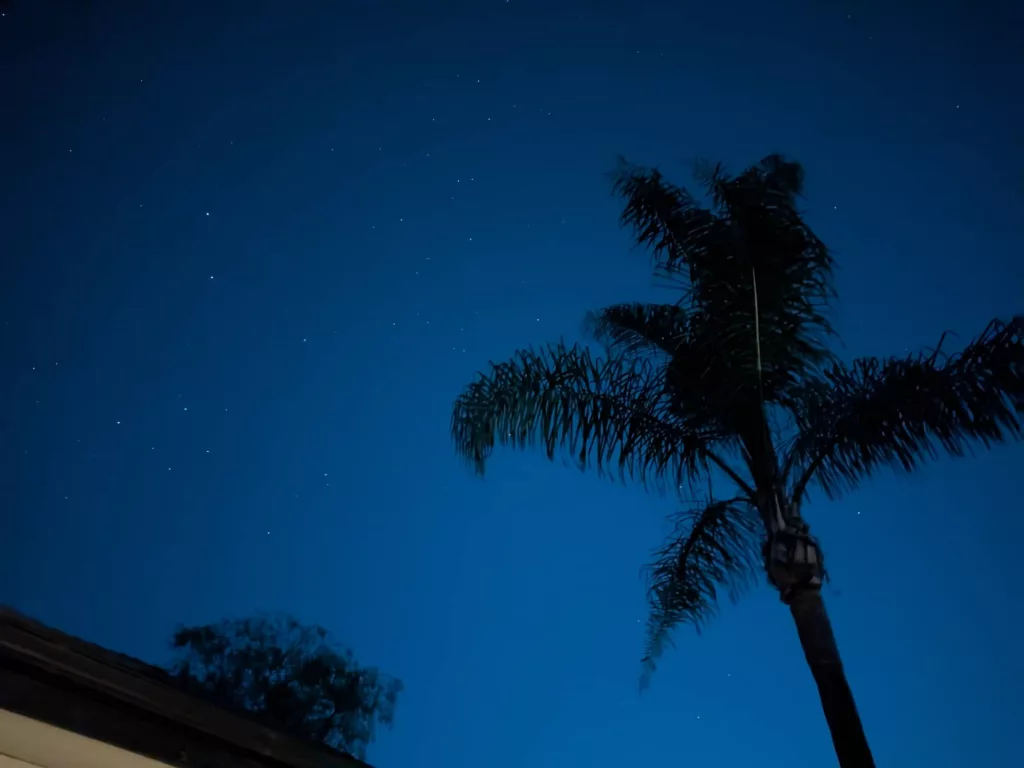
Some people will care, and some won’t, though the Pixel 9 Pro Fold attempts to make up for some of this with some handy additions.
For instance, you can snap selfies using the rear camera by looking into the cover screen. That’s a feature we’ve seen on the Moto Razr models and even the Samsung equivalents, so it’s not all that special, though it is handy.
Google has also included a fun animated mode to help kids look at the camera’s cover screen in “made you look”, showing animated animals to keep their eyes focused in the right place. The flaw in this approach is that it doesn’t work in portrait mode, only in standard photos, which definitely feels like a missed opportunity for Google.
Battery
Underneath all of this is a 4650mAh battery, a decent amount when you consider that big phones typically arrive with 5000mAh, and this isn’t far from that.
Testing the Pixel 9 Pro Fold over several days, the handset managed to deliver 24 hours of regular use with no problems, and could hit closer to 30 depending on how often you used that larger internal screen.

For most people, we suspect a nightly charge will be what happens, and given the roughly four hours of screen time possible from the phone, it should come as no surprise. You’ll split your time between the large outside screen and the obviously larger inside screen, but depending on which you use more, expect the battery to waiver.
More time using the 8 inch screen on the inside will mean less battery life on the whole. Balance it well, however, and a full day’s charge seems easily possible, a result we saw several times.
Value
The price is where things get complex, because as a foldable, the Pixel 9 Pro Fold is not cheap. Virtually no foldable is at the moment; phones that fold are still relatively new, so naturally command a higher price.
Still, at a starting price of $2699, the Google Pixel 9 Pro Fold is certainly pricey. It’s more expensive than the Pixel 9 Pro XL, easily one of the best Android phones of the year, and it doesn’t even share all the same features.
You’ll miss out on speedy wireless charging, the same rear camera system as the other 9 Pro models, a 42 megapixel selfie camera, better water resistance, and you’ll pay more for it. Fold owners will get an extra screen, sure, but they’ll pay over $700 more for the privilege, and we’re not entirely sure that it’s worth that.
Yes, it’s an extra screen. Yes, it lets you potentially do more. It’s a little like having an Android tablet inside of a phone with you. But we don’t think Google has possibly made the most of its screen, or even the feature set.

The Pixel 9 Pro Fold isn’t quite the same as a Pixel 9 Pro or Pixel 9 Pro XL. It’s certainly made in the same image and is similar, but it’s not cut from the same cloth. Almost almost, just not quite.
The one upside could be the street price, with select telco partners offering the Fold at launch with a saving of $800. Hitting that price could make the Pixel 9 Pro Fold that much better value. It’s still expensive, especially when the Pixel 9 Pro XL is technically a better phone, but at under $2K, it offers a seriously compelling foldable all things considered.
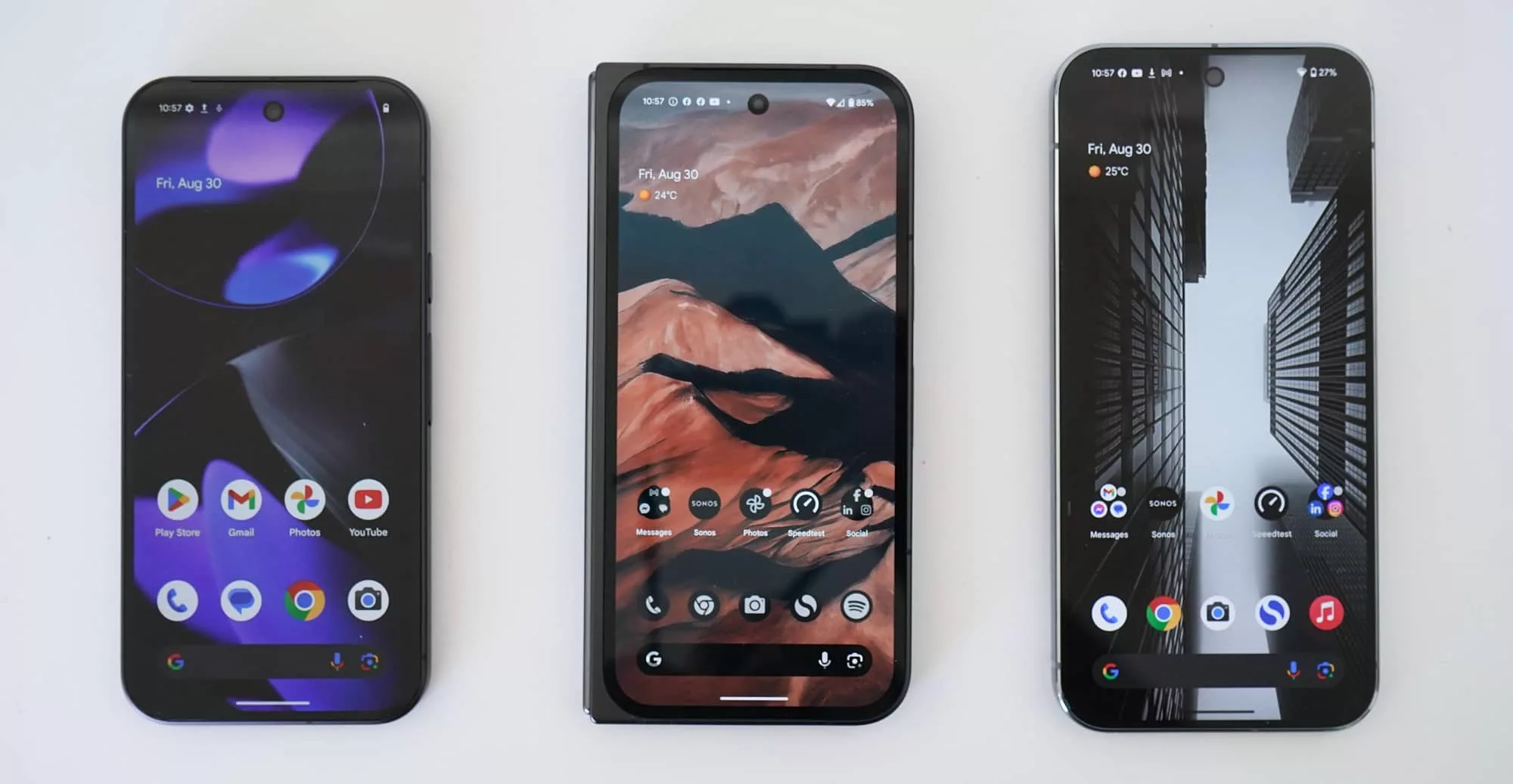
What needs work?
And all things considered, the camera should not only be better, the camera should be the same.
Google has called the Pixel 9 Pro Fold a “Pixel 9 Pro”, and both of the other Pixel 9 Pro models literally share identical camera systems.
But the Pixel 9 Pro Fold carries the name and a completely different stack. It borrows the same logic — wide, ultrawide, and 5X telephoto — but the sensors and camera capability aren’t on the same level. You’ll get fewer megapixels to work with and less impressive sensors.
The 9 Pro Fold camera system isn’t as impressive as other models carrying the “Pixel 9 Pro” name, and that’s a miss.
It’s more like a Pixel 9a Pro Fold: similar but not the same, and in a similar approach to what Google does with its “a” variant Pixels.
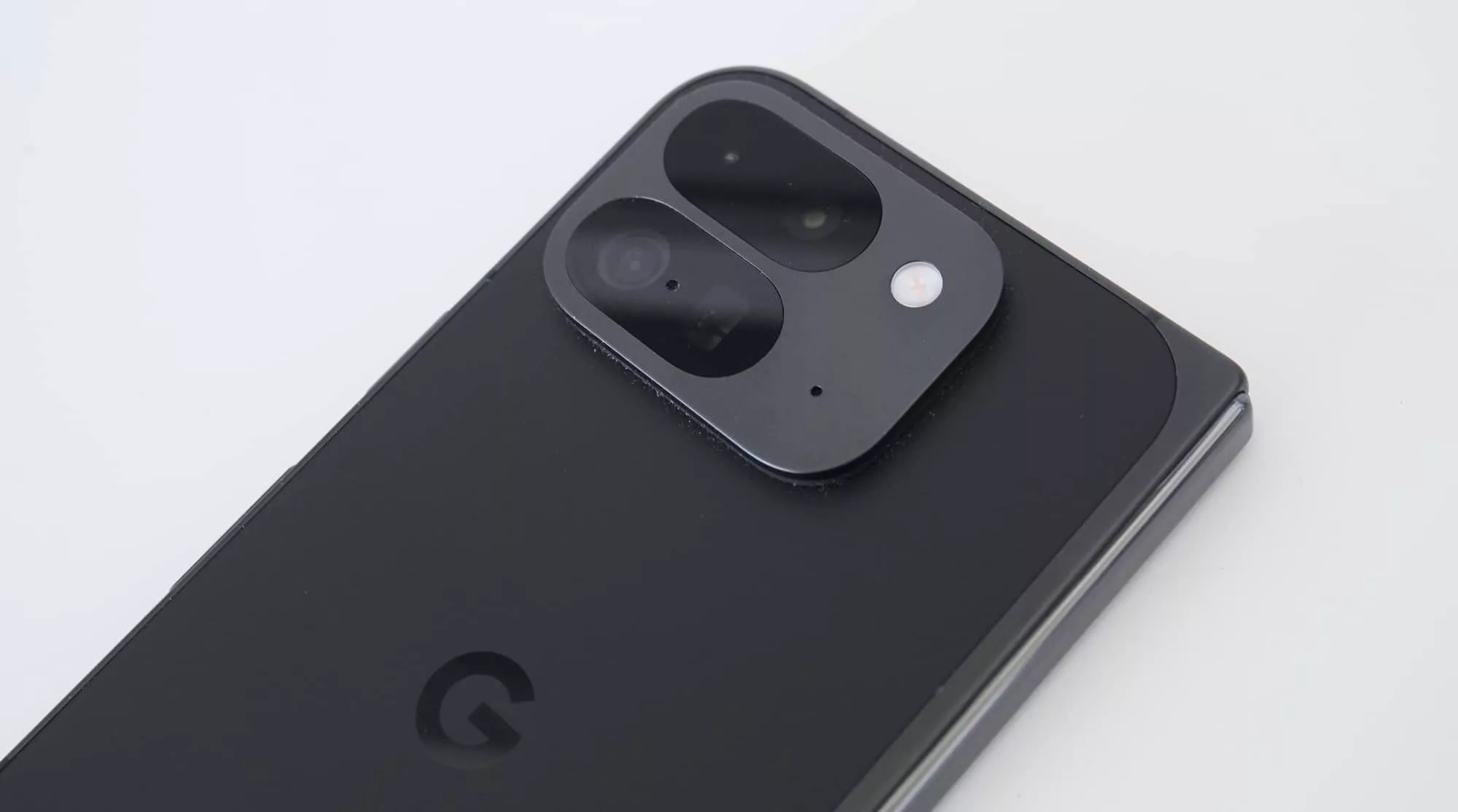
As is the lack of support for Qi2, which feels like it should definitely be here. It’s a brand new phone, and one that could should last for years to come. It’s a near-$3K phone, and yet Qi2 is nowhere to be seen. It’s in a sub-$1K phone from HMD, so it should definitely be here.
And since we’re weighing up everything, it feels as though Google should apply some more tweaks to the tablet experience as well, just something to make it stand out that little bit more.
The Samsung Galaxy Z Fold 6 has support for the S-Pen, even if the pen isn’t included. But the support is there, so that’s something.
Here on the Pixel 9 Pro Fold, it is just a tablet. And sure, a tablet is all you may need inside of a phone, but the tablet isn’t doing a whole lot of difference for most of the apps we tried. They’re just bigger.

Google does provide a small dock (above) to let you browse other apps while you’re in viewing the full screen for the apps, but that is about it.
This is just a slightly bigger, slightly wider phone experience. For some, that’ll be fine. For us, we’re looking for more.
What we love
Despite these issues, the Pixel 9 Pro Fold has been a foldable we’ve enjoyed using more than others, and it may come down to the size.
We’re not quite at the level where foldables can be as thin as other phones, but once you factor in the thickness of the cameras on both the Pixel 9 Pro XL and the Pixel 9 Pro Fold, neither phone feels remarkably different in this way.
The Pixel 9 Pro Fold technically has more depth — the 10.5mm thickness is greater than the 8.5mm of this year’s big Pixel — but you don’t always feel it.

Quite the contrary, in fact. This phone just feels better balanced than other foldable tablet-phone styled devices. It’s quite well balanced, and hardly hinders your pockets in the way other foldables can.
It’s thinner than Samsung’s sixth-gen Galaxy Fold in all the right places: closed it’s 10.5mm compared to the 12.1mm of the Fold 6, while opened, the 5.1mm sections are slimmer than the 5.6mm sections of Samsung’s equivalent.
Google even managed to match the 5.1mm thickness of the 13 inch M4 iPad Pro. It’s impressive hardware design.
Google could still have improved the screen technology and decreased the crease, you’ll get no disagreements from this reviewer here, but overall this reads as a likeable foldable. That’s a big win.
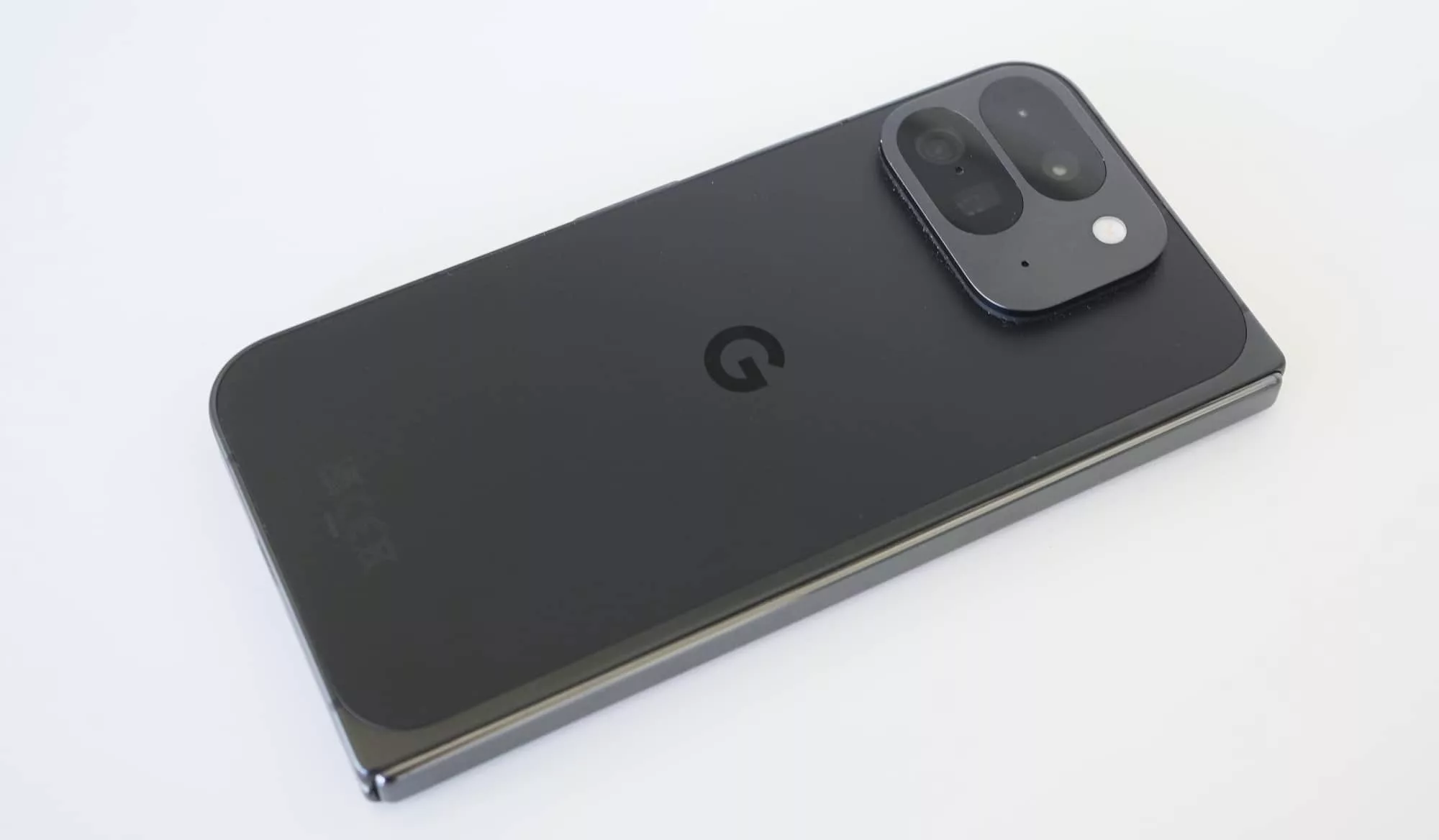
Final thoughts (TLDR)
There are definite ways Google’s likeable foldable could be better, but even in its second generation, there are aspects that are incredibly appealing.
Thinner than the competition, the Pixel 9 Pro Fold stands out positively by being different enough to what you can find from Samsung. Google has more chops in the camera department, a bigger screen, and somehow a thinner design working for it.
In terms of nailing the brief of building the best foldable, Google has achieved it with flying colours. In this form-factor, the Google Pixel 9 Pro Fold is the handset to check out if you want the best of both worlds: a phone and tablet in the one package.
Now the problem is how to get the most out of both of them. Android phones are already a force to be reckoned with, but Android tablets haven’t quite managed to usurp the iPad, and we’re not sure this will either.
You may not care, however. If what you want is a bigger screen for the odd times you need one, the Pixel 9 Pro Fold makes a compelling case worthy of consideration, especially if you can find it at a price lower than the $2699 it costs in Australia.


